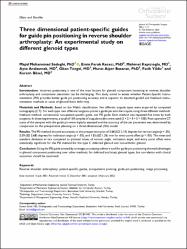| dc.contributor.author | Kececi, Emin Faruk | |
| dc.contributor.author | Sadeghi, Majid Mohammad | |
| dc.contributor.author | Kapicioglu, Mehmet | |
| dc.contributor.author | Aralasmak, Ayse | |
| dc.contributor.author | Tezgel, Okan | |
| dc.contributor.author | Basaran, Murat Alper | |
| dc.contributor.author | Yildiz, Fatih | |
| dc.contributor.author | Bilsel, Kerem | |
| dc.date.accessioned | 2022-06-30T13:49:14Z | |
| dc.date.available | 2022-06-30T13:49:14Z | |
| dc.date.issued | 2022 | en_US |
| dc.identifier.issn | 1022-5536 | |
| dc.identifier.issn | 2309-4990 | |
| dc.identifier.other | WOS:000765352200001 | |
| dc.identifier.uri | https://doi.org/10.1177%2F10225536221079432 | |
| dc.identifier.uri | https://hdl.handle.net/20.500.12573/1304 | |
| dc.description.abstract | Introduction Incorrect positioning is one of the main factors for glenoid component loosening in reverse shoulder arthroplasty and component placement can be challenging. This study aimed to assess whether Patient-Specific Instrumentation (PSI) provides better guide pin positioning accuracy and is superior to standard guided and freehand instrumentation methods in cases of glenoid bone deformity. Materials and Methods Based on the Walch classification, five different scapula types were acquired by computed tomography (CT). For each type, two different surgeons placed a guide pin into the scapula using three different methods: freehand method, conventional non-patient-specific guide, and PSI guide. Each method was repeated five times by both surgeons. In these experiments, a total of 150 samples of scapula models were used (5 x 2 x 3 x 5 = 150). Post-operative CT scans of the samples with the guide pin were digitally assessed and the accuracy of the pin placement was determined by comparison to the preoperative planning on a three-dimensional (3D) model. Results The PSI method showed accuracies to the preoperative plan of 2.68 (SD 2.10) degrees for version angle (p < .05), 2.59 (SD 2.68) degrees for inclination angle (p < .05), and 1.55 (SD 1.26) mm for entry point offset (p < .05). The mean and standard deviation errors compared to planned values of version angle, inclination angle, and entry point offset were statistically significant for the PSI method for the type C defected glenoid and non-arthritic glenoid. Conclusion Using the PSI guide created by an image processing software tool for guide pin positioning showed advantages in glenoid component positioning over other methods, for defected and intact glenoid types, but correlation with clinical outcomes should be examined. | en_US |
| dc.language.iso | eng | en_US |
| dc.publisher | SAGE PUBLICATIONS LTD1 OLIVERS YARD, 55 CITY ROAD, LONDON EC1Y 1SP, ENGLAND | en_US |
| dc.rights | info:eu-repo/semantics/openAccess | en_US |
| dc.subject | Reverse shoulder arthroplasty | en_US |
| dc.subject | patient-specific guides | en_US |
| dc.subject | preoperative planning | en_US |
| dc.subject | guide pin positioning | en_US |
| dc.subject | image processing | en_US |
| dc.title | Three dimensional patient-specific guides for guide pin positioning in reverse shoulder arthroplasty: An experimental study on different glenoid types | en_US |
| dc.type | article | en_US |
| dc.contributor.department | AGÜ, Mühendislik Fakültesi, Makine Mühendisliği Bölümü | en_US |
| dc.contributor.authorID | 0000-0001-8654-855X | en_US |
| dc.contributor.institutionauthor | Keçeci, Emin Faruk | |
| dc.identifier.volume | 30 | en_US |
| dc.identifier.issue | 1 | en_US |
| dc.identifier.startpage | 1 | en_US |
| dc.identifier.endpage | 11 | en_US |
| dc.relation.journal | JOURNAL OF ORTHOPAEDIC SURGERY | en_US |
| dc.relation.publicationcategory | Makale - Uluslararası Hakemli Dergi - Kurum Öğretim Elemanı | en_US |


















